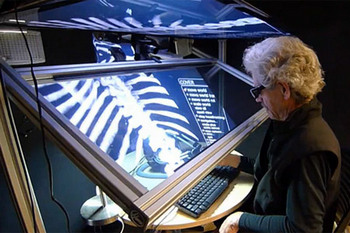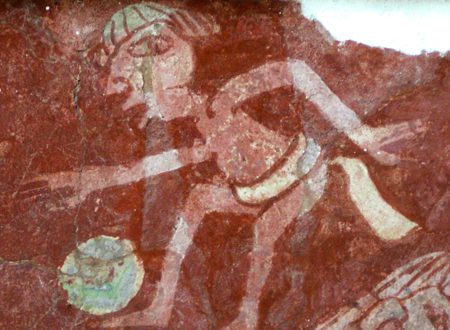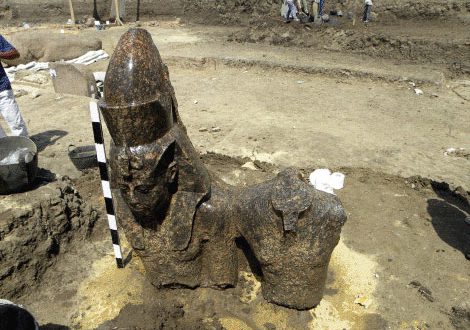 Archaeologists excavating in the Guatamalanjunglehave discovered a royal tomb, filled with colourful 1,600-year-old Mayan artefacts, beneath the El Diablo pyramid. The well preserved tombis packed with carvings, ceramics, textiles, and the bones of six children, possibly the remains of a human sacrifice.
Archaeologists excavating in the Guatamalanjunglehave discovered a royal tomb, filled with colourful 1,600-year-old Mayan artefacts, beneath the El Diablo pyramid. The well preserved tombis packed with carvings, ceramics, textiles, and the bones of six children, possibly the remains of a human sacrifice.
The archaeological team, led by Stephen Houston, professor of anthropology at Brown University, uncovered the tomb beneath the El Diablo pyramid in the city of El Zots, Guatamalain May. Last week, the discovery of the tomb, dated to between 350 and 400AD, was made public.
Houston said the first pointer to the discovery was something odd in the deposit the team was digging, at a small temple built in front of a sprawling structure dedicated to the sun god, an emblem of Maya rulership.
When we sunk a pit into the small chamber of the temple, we hit almost immediately a series of caches – blood-red bowls containing human fingers and teeth, all wrapped in some kind of organic substance that left an impression in the plaster. We then dug through layer after layer of flat stones, alternating with mud, which probably is what kept the tomb so intact and airtight.
Then, on May 29th 2010, Houston was with a worker who came to a final earthen layer.
I told him to remove it, and then, a flat stone. Wed been using a small stick to probe for cavities. And, on this try, the stick went in, and in, and in. After chipping away at the stone, I saw nothing but a small hole leading into darkness.
They lowered a bare light bulb into the hole, and suddenly Houston saw an explosion of color in all directions – reds, greens, yellows. It was a royal tomb filled with organics Houston says hed never seen before: pieces of wood, textiles, thin layers of painted stucco and cord.
When we opened the tomb, I poked my head in and there was still, to my astonishment, a smell of putrification and a chill that went to my bones, the dig’s director said. The chamber had been so well sealed, for over 1600 years, that no air and little water had entered.
 The tomb itself is about 6 feet high, 12 feet long, and four feet wide. I can lie down comfortably in it, Houston said, although I wouldnt want to stay there.
The tomb itself is about 6 feet high, 12 feet long, and four feet wide. I can lie down comfortably in it, Houston said, although I wouldnt want to stay there.
It appears the tomb held an adult male, who was between 50 and 60 he died from natural causes, but the team’s bone analyst, Andrew Scherer, assistant professor of anthropology at Brown, has not yet confirmed the finding.
And who was this man buried with such a wealth? Though the findings are still very new, the group believes the tomb is likely from aruler they only know about from hieroglyphic texts.
These items are artistic riches, extraordinarily preserved from a key time in Maya history, said Houston. From the tombs position, time, richness, and repeated constructions atop the tomb, we believe this is very likely the founder of a dynasty.
According to Houston, the tomb shows that the ruler is going into the tomb as a ritual dancer: He has all the attributes of this role, including many small bells of Spondylus shell with, probably, dog canines as clappers. There is a chance too, that his body, which rested on a raised bier that collapsed to the floor, had an elaborate headdress with small glyphs on them. One of his hands may have held a sacrificial blade.
The blade was probably used for cutting and grinding through bone or some other hard material, and its surface seems to be covered with red organic residue. Though the substance still needs to be tested, it doesnt take too much imagination to think that this is blood, Houston said.
So far, it seems likely that there are six children in the tomb, some with whole bodies and probably two solely with skulls. The children – ranging in age from 1to 5 – were “probably sacrificed”in honour of the ruler.
We still have a great deal of work to do, Houston said. Remember, weve only been out of the field for a few weeks and were still catching our breath after a very difficult, technical excavation. Royal tombs are hugely dense with information and require years of study to understand. No other deposits come close.
The ancient Maya kingdom of El Zotz is located within a day’s walk (about 20kms) from Tikal, the capital of one of the largest and most powerful kingdoms of the ancient Maya.Yet, El Zotzflourished in the midst of the 1st millennium AD- after Tikal was defeated by Caracol (Belize) and Calakmul (Mexico).It is likely thatEl Zotz allied with Tikal’s enemies and that relations between the two cities were hostile. According to a textfound atTikal, in the 8th century AD,El Zotz wasengaged in battle against Tikal, and the last known hieroglyphic inscription to refer to El Zotz describes the city as being the target of an attack by Tikal.




